Geothermal energy is a clean and sustainable power source. It has a low carbon footprint, making it great for the environment. This energy is a key part of the sustainable energy mix, providing stable power all year.
For thousands of years, people have used geothermal energy for heating and cooking. Building geothermal power plants can affect the environment, but with careful planning, these issues can be managed. This makes geothermal a good choice for reducing fossil fuel use and environmental impact.
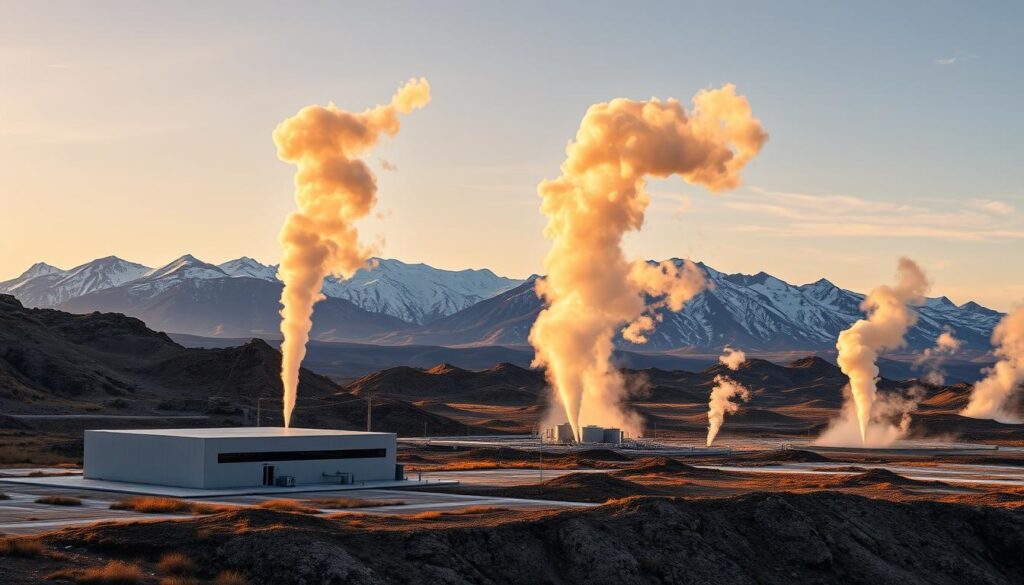
As we move towards cleaner energy, geothermal is becoming more important. It has a low carbon footprint and offers reliable energy. Understanding its pros and cons helps us see its role in a greener future.
Key Takeaways
- Geothermal energy is a renewable and sustainable source of energy with a low carbon footprint.
- Geothermal power plants emit 97% less acid rain-causing sulfur compounds and nearly 99% less carbon dioxide than fossil fuel power plants.
- Geothermal energy can provide a stable energy source 365 days a year, making it an attractive option for those looking to reduce their reliance on fossil fuels.
- The construction of geothermal power plants can have a significant environmental impact, including the release of hydrogen sulfide gas and the potential for earthquakes.
- Geothermal energy has the potential to reduce our reliance on fossil fuels and mitigate climate change, making it an important component of the sustainable energy mix.
- Proper planning and management are necessary to mitigate the risks associated with geothermal energy production and ensure a sustainable future.
- Geothermal energy is expected to be available for roughly another 4-5 billion years, making it a long-term solution for our energy needs.
Understanding Geothermal Energy Basics
Geothermal energy comes from the heat inside the Earth’s surface. It’s used for electricity and heating/cooling. This clean energy is key as we move towards sustainable options.
It taps into the Earth’s core heat to power homes and businesses. This makes it a vital part of our energy mix.
Geothermal energy is a green alternative to fossil fuels. It cuts down on harmful emissions and helps fight climate change. It’s also a reliable source of power, making it perfect for our future needs.
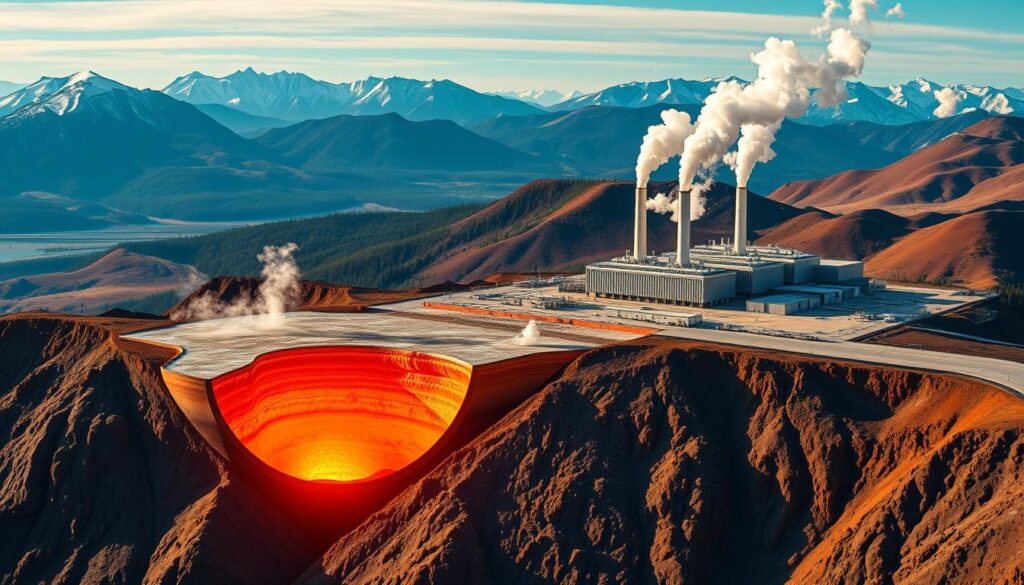
- Consistent electricity generation, operating 24 hours a day, 7 days a week
- Low life cycle emissions, four times lower than solar PV and six to 20 times lower than natural gas
- Low water consumption, with geothermal power plants occupying less land per gigawatt-hour compared to other energy sources
Learning about geothermal energy opens up new possibilities. It helps us create a cleaner, greener world for tomorrow.
Environmental Impact of Geothermal Power
Geothermal energy is seen as environmentally friendly. It has a small carbon footprint compared to traditional fuels. The environmental impact of geothermal power is key, as it’s a renewable energy source with low greenhouse gas emissions. Studies show geothermal power plants emit about 38gCOeq/kWh of greenhouse gases. This is 95% less than coal and 92% less than natural gas.
Using sustainable energy like geothermal power helps us use less fossil fuels. This leads to less air pollution and greenhouse gas emissions. Some benefits of geothermal energy include:
- Low greenhouse gas emissions: Geothermal power plants emit very little carbon dioxide, methane, and other greenhouse gases.
- Water conservation: Geothermal power plants use less water over their lifetime compared to most other electricity-generation technologies.
- Land conservation: Geothermal power plants need less land per gigawatt-hour, requiring 404 m², compared to coal, wind, and solar PV.
The environmental impact of geothermal power is low. This makes it a good choice for those wanting to cut their carbon footprint and use renewable energy. As we move towards sustainable energy sources, geothermal power will become more important in the global energy mix.

Cost Considerations for Geothermal Installation
Thinking about getting a geothermal system? It’s key to look at the costs first. The start-up price can be high, from $10,000 to $30,000. But, you’ll save money in the long run and spend less on upkeep.
Homeowners can cut their heating bills by 70% and cooling costs by 50%. This means saving over $1,000 each year.
The savings depend on the system you choose. Ground-source heat pumps are super efficient, beating traditional furnaces by a lot. Plus, there’s a tax credit of 30% of the system’s cost. This makes geothermal systems more appealing to homeowners.
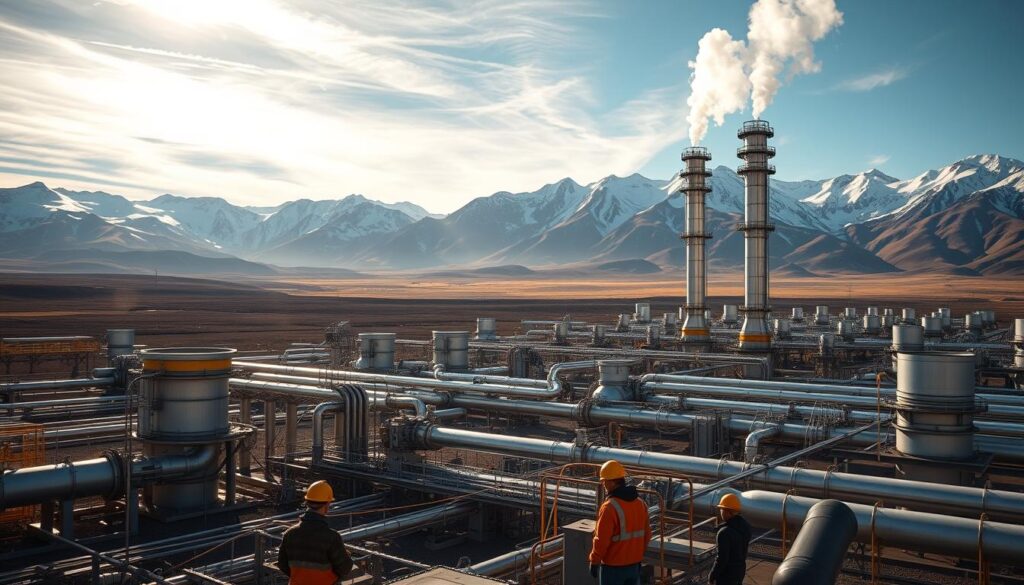
Several things can change the cost of installing a geothermal system. These include:
- System type and size
- Soil type and geological conditions
- Existing ductwork and infrastructure
- Permitting and installation costs
It’s important to think about these factors and the costs of renewable energy. This way, you can make a smart choice. You’ll save money and help the planet, making geothermal a great choice for many.
Geothermal Energy in Residential Applications
Geothermal energy is a reliable and efficient source of energy for homes. It provides both heating and cooling. This renewable energy solution can greatly reduce a household’s carbon footprint and energy bills.
Homeowners can save up to 60% on heating costs and 50% on cooling costs. This is compared to traditional HVAC systems.
Some of the benefits of geothermal energy in homes include:
- Low operating costs
- High efficiency, with some systems operating at 300-500% efficiency
- Long system lifespan, with ground source heat pumps lasting over 50 years
- Reduced greenhouse gas emissions, with the ability to cut emissions by up to 75%
Recent data shows geothermal systems can achieve over 90% conversion efficiency. This makes them a highly efficient renewable energy solution. Geothermal energy can also be used in various property sizes, including urban settings. Many systems use vertical ground loops.
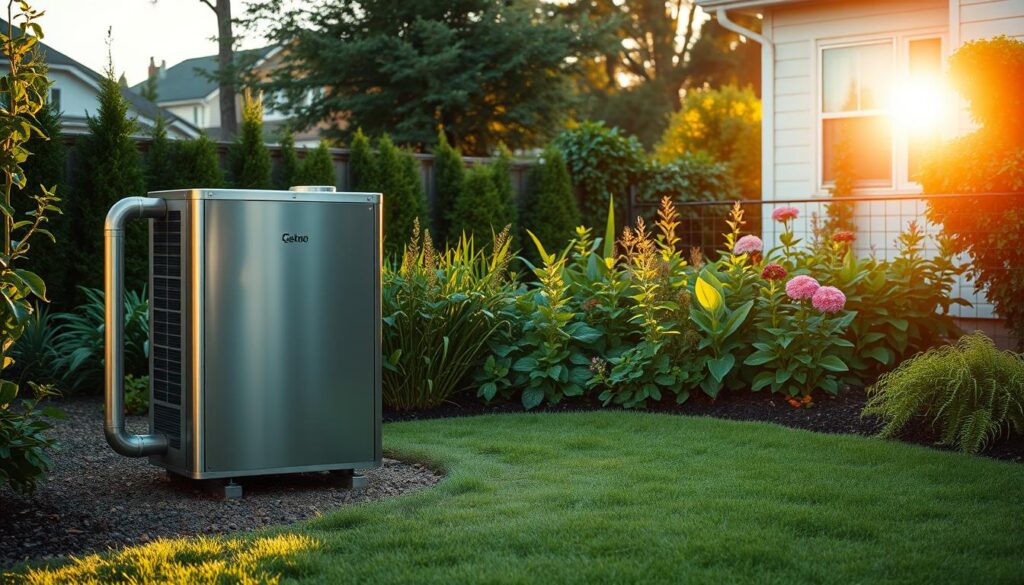
| System Type | Lifespan | Efficiency |
|---|---|---|
| Geothermal Heat Pump | 20-25 years | 300-500% |
| Conventional Furnace | 15-20 years | 80-90% |
| Air Conditioning System | 10-15 years | 10-15% |
Commercial Uses and Industrial Benefits
Geothermal energy is very useful for many sectors. It’s a reliable power source, perfect for industrial needs. It also helps in agriculture, like heating greenhouses and keeping animals warm.
Geothermal energy is cost-effective and eco-friendly. Its power plants run efficiently, often over 80%. It’s also great for heating whole communities, cutting down on fossil fuel use.
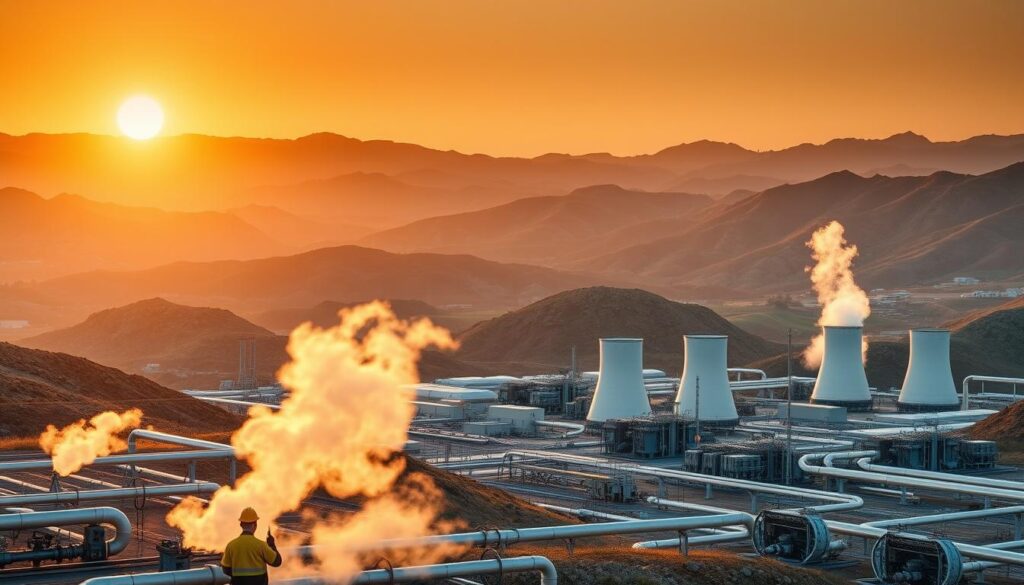
Geothermal energy has many uses. As technology gets better, so do its applications. Some key uses include:
- Industrial processing and manufacturing
- Agricultural heating and cooling
- District heating systems
Geothermal energy is key to a green and sustainable energy mix. It offers many benefits for both industries and the environment.
Sustainability Factors of Geothermal Resources
Geothermal energy is a renewable energy source with a low environmental impact. The Earth’s core is about 4,000 miles deep, with temperatures over 7,200 degrees F. This heat can be used to make electricity, making geothermal a key part of the shift to renewable energy.
The sustainability factors of geothermal resources are many. For example, geothermal power plants can run for up to 80 years. Some have even lasted over 100 years. Also, geothermal energy creates more jobs per installed megawatt than other renewable energy sources. Here are some key benefits of geothermal resources:
- Low environmental impact
- High renewable energy production
- Long-lasting power plants
- Job creation in the geothermal resources sector
As we move towards renewable energy, the role of sustainability factors in geothermal resources is critical. Geothermal energy can power millions of homes and cut greenhouse gas emissions. It’s a vital part of a sustainable future.
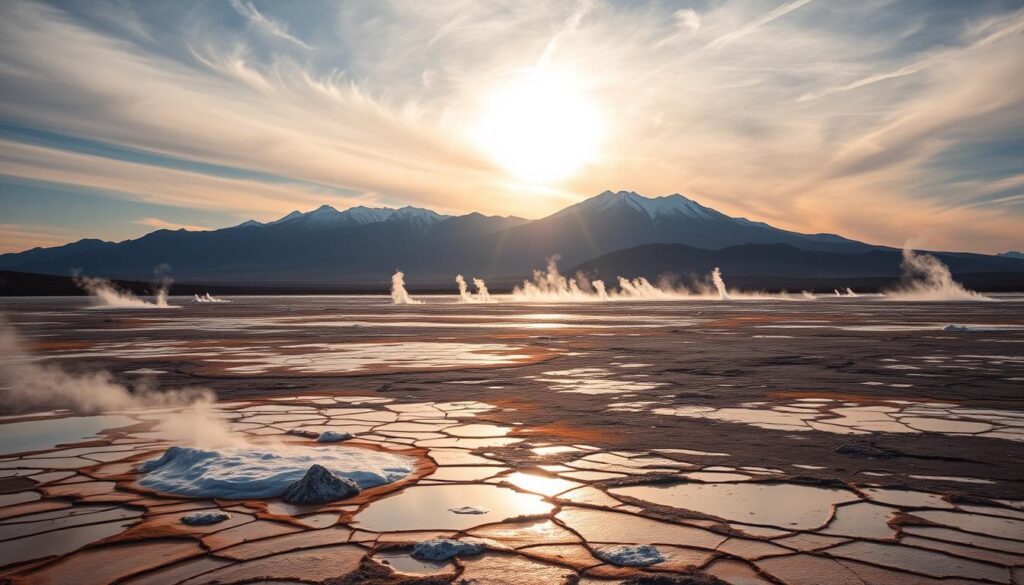
| Country | Geothermal Energy Production |
|---|---|
| Iceland | Over 25% |
| Hawaii | Aiming for 100% by 2045 |
Geographical Limitations and Requirements
Geothermal energy is a clean, renewable source. But, it has limits based on where it can be found. Places with tectonic plate boundaries or hot spots are best for geothermal power plants.
Some key things needed for geothermal energy include:
- Being close to tectonic plate boundaries or hot spots
- Enough heat from the Earth’s core
- Rock that lets water flow easily
- Enough water for cooling systems
Geothermal energy is a reliable, green option. It can help us use less fossil fuels and cut down on pollution. Knowing where geothermal can work best helps us move towards a greener future.
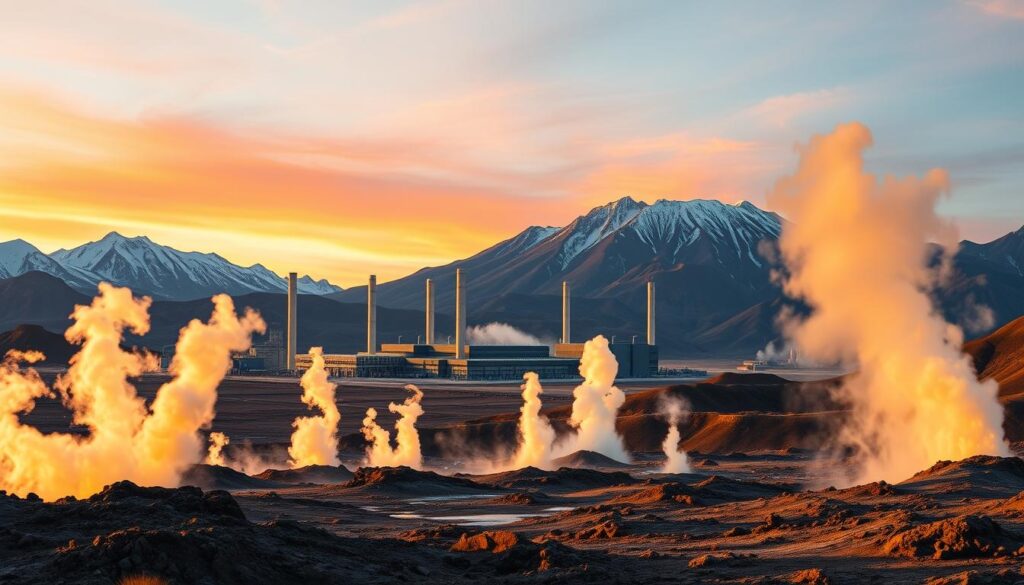
As we move to cleaner energy, we must think about geothermal’s needs. This way, we can use geothermal fully and make our energy mix cleaner and greener.
| Country | Geothermal Energy Production (MW) |
|---|---|
| Iceland | 755 |
| United States | 2,545 |
| Philippines | 1,904 |
Technological Advancements in Geothermal Systems
Geothermal energy is becoming more popular as a renewable energy source. Technological advancements are key to its growth. The industry is working hard to make geothermal systems more efficient and affordable. Enhanced geothermal systems (EGS) are a big step forward. They can use hot rock formations to generate electricity.
Some important technological advancements in geothermal systems include:
- Advanced drilling technologies to access deeper and hotter rock formations
- Improved reservoir management to increase the lifespan of geothermal reservoirs
- Enhanced power generation technologies to increase the efficiency of geothermal power plants
These improvements will help geothermal energy become more widely used. It will reduce our need for fossil fuels and help fight climate change. As research and development continue, we can look forward to even better geothermal systemsin the future.
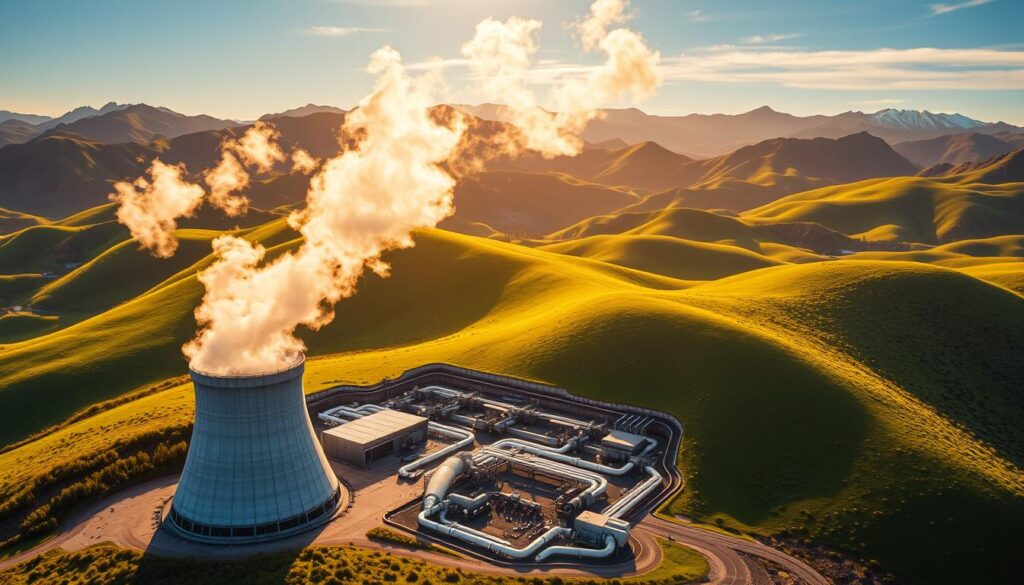
| Technology | Description | Benefits |
|---|---|---|
| Enhanced Geothermal Systems (EGS) | Tap into hot rock formations to produce electricity | Increased efficiency, reduced costs |
| Advanced Drilling Technologies | Access deeper and hotter rock formations | Increased power generation, reduced exploration risks |
| Improved Reservoir Management | Increase the lifespan of geothermal reservoirs | Reduced maintenance costs, increased power generation |
Comparing Geothermal to Other Renewable Sources
Geothermal energy is known for its dependability and steady supply. It has a higher capacity factor than solar and wind energy. This means geothermal power plants can run all the time, giving a constant flow of electricity.
Solar energy, on the other hand, depends on the weather. It’s a good choice for many uses, but it’s not as steady as geothermal. Comparing renewable sources helps find the best fit for different needs.
Geothermal energy is special because it can give both heat and electricity. This is great for places that need both, like factories or buildings that heat entire neighborhoods.
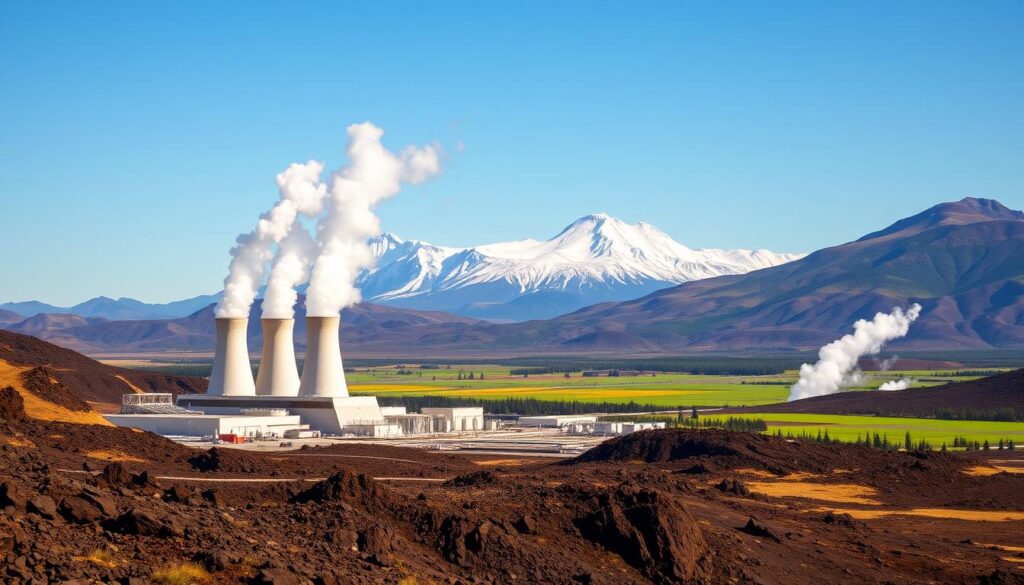
It can also work well with solar energy to make a system that’s both efficient and reliable.
Geothermal energy has many benefits. It’s reliable, consistent, and can provide both heat and electricity. It can also team up with other renewable sources. So, geothermal energy is a solid choice for many uses.
Maintenance and Operational Considerations
Geothermal energy production needs careful maintenance and operation to work well. Maintenance considerations are key to keeping costs low and systems running smoothly. Recent data shows geothermal facilities have lower maintenance costs than other renewable energy sources.
Important maintenance steps include regular checks, proper design, and quick repairs. These steps help avoid downtime and boost energy output. Also, using the latest technologies and materials can cut down on maintenance considerationsand make geothermal systems more efficient.
Here are some benefits of proper maintenance in geothermal energy production:
- Reduced downtime and increased energy production
- Lower maintenance costs and extended system lifespan
- Improved overall efficiency and reliability of geothermal systems
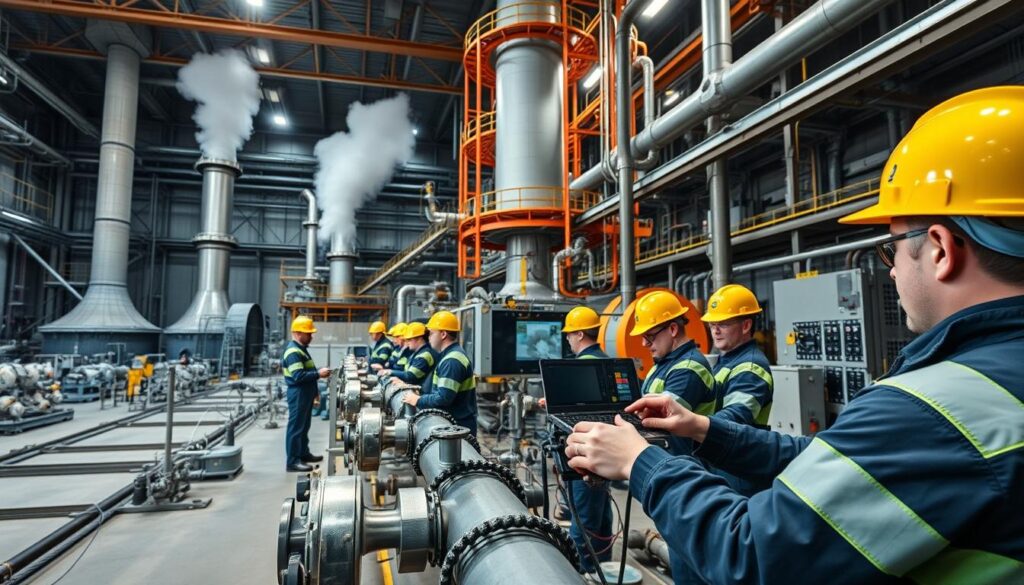
In conclusion, maintenance considerations are essential for geothermal energy systems to work efficiently and reliably. By focusing on these factors, operators can maximize the benefits of geothermal energy as a renewable energy source. This helps move us towards a more sustainable future.
| Maintenance Activity | Frequency | Benefits |
|---|---|---|
| Regular inspections | Monthly | Early detection of issues, reduced downtime |
| System design review | Quarterly | Optimized performance, improved efficiency |
| Timely repairs | As needed | Minimized downtime, extended system lifespan |
Government Incentives and Support Programs
Geothermal energy gets a boost from government incentives and support programs. These efforts help make renewable energy more common. They aim to cut down on fossil fuel use and fight climate change. You’ll find federal tax credits, state incentives, and local rebates for geothermal energy.
Geothermal energy is key to our renewable energy mix. It offers a steady power source. Using it can lower greenhouse gas emissions, making our carbon footprint smaller. Governments offer grants and tax credits to make starting geothermal projects easier.
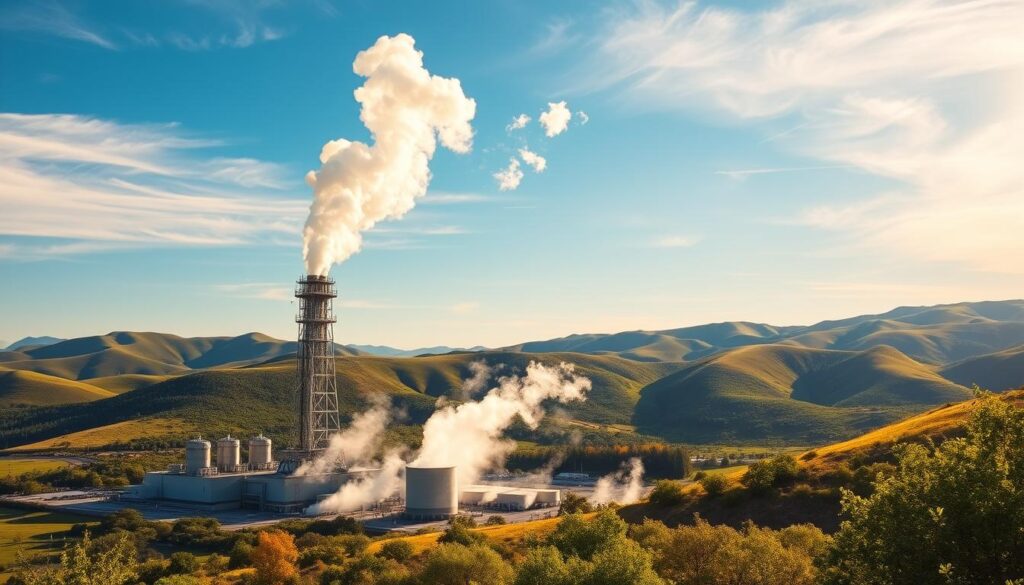
Government incentives for geothermal energy have many benefits. They include:
- More investment in geothermal projects
- More jobs in the geothermal sector
- Less greenhouse gas emissions
- Better energy security
With these incentives, governments can grow the geothermal energy industry. This supports a cleaner, more sustainable energy future.
| Government Incentive | Description |
|---|---|
| Federal Tax Credits | Helps offset costs for starting geothermal projects |
| State-Level Incentives | Supports geothermal energy development at the state level |
| Local Rebate Programs | Encourages using geothermal energy systems locally |
Job Creation and Economic Impact
The geothermal energy industry is growing fast, creating new jobs and boosting local economies. As more people look for clean energy, geothermal is seeing big growth. This means more job creation in finding, building, and running geothermal power plants.
The economic impact of geothermal energy is huge, bringing in a lot of money for local areas. The industry has already created thousands of jobs worldwide. It’s expected to keep growing, helping local economies by buying goods and services.
Geothermal energy is making a big difference in many ways. Here are some examples:
- Creating jobs in building and running geothermal power plants
- Helping local economies by buying goods and services
- Bringinging in money for local communities through taxes and royalties

The geothermal energy industry is set to keep growing. This is thanks to more demand for clean energy and government support for geothermal projects. As it grows, it will likely help local communities even more, creating jobs and bringing in revenue through geothermal energy.
Current Market Trends and Future Projections
The geothermal energy market is growing fast. This is because more people want clean, sustainable energy. In 2021, the global geothermal energy market was worth USD 59.40 billion. It’s expected to grow by 6.3% each year until 2029.
Recently, the size of geothermal turbines has gone up a lot. In 2011, they were 3.3 MW. By 2020, they were 7.6 MW.

Now, there are plans for even bigger turbines, up to 15 MW. This shows the industry is looking bright. Also, combining geothermal with other renewables is becoming more common. This makes power systems more reliable.
Some important market trends and future projections for geothermal energy are:
- More people want renewable energy
- More money is being put into geothermal projects
- New tech, like binary cycle plants, is coming out
- Geothermal is being used more in industries
The geothermal energy market is set to grow a lot. This is because of the demand for clean energy. As it grows, geothermal will become even more important. It’s expected to reach USD 125.9 billion by 2032.
Conclusion
Geothermal energy is a clean, renewable, and reliable power source. It has vast underground reservoirs that could last up to 17 billion years. This makes it a sustainable solution for our energy needs.
Geothermal power plants produce 99% less carbon dioxide than traditional fossil fuel plants. This makes it key in fighting climate change.
The initial cost of geothermal energy systems is high. But, the long-term savings and low maintenance costs offer significant financial benefits. Also, geothermal operations require less land than other renewable sources, making it ideal for densely populated areas.
As technology improves, costs go down and efficiency increases. The future of renewable energy is in geothermal power. By using the natural heat beneath our feet, we can create a cleaner, sustainable energy landscape for future generations.
FAQ
What is geothermal energy?
Geothermal energy comes from the Earth’s heat inside. It’s a green energy because the Earth keeps replenishing it. This makes it a sustainable choice.
How do geothermal systems work?
Geothermal systems tap into the Earth’s heat. They use wells to get this heat. Then, they turn it into energy for buildings or electricity.
What are the different types of geothermal resources?
There are many types of geothermal resources. These include hot water or steam, enhanced geothermal systems, and ground-source heat pumps. Each type has its own way of being used.
What are the environmental benefits of geothermal energy?
Geothermal energy is clean and green. It makes little to no greenhouse gases. This makes it better for the environment than fossil fuels.
What are the environmental drawbacks of geothermal energy?
Geothermal energy is mostly good, but it has some downsides. It can cause land to sink, create earthquakes, and pollute water in some cases.
What are the cost considerations for geothermal installation?
Starting with geothermal can cost a lot at first. But, it saves money in the long run. Plus, there are government incentivesto help with the cost.
How can geothermal energy be used in residential applications?
Geothermal energy is great for homes. It heats and cools efficiently. Geothermal heat pumps are a common way to use it at home.
What are the commercial and industrial applications of geothermal energy?
Geothermal energy is useful for businesses too. It can power industrial processes, heat greenhouses, and even warm buildings in district heating systems.
What are the sustainability factors of geothermal resources?
Geothermal resources are sustainable. They’re naturally replenished and have less environmental impact than fossil fuels. But, how sustainable they are depends on how they’re used.
What are the geographical limitations and requirements for geothermal energy production?
Geothermal energy needs the right geological conditions. It requires areas with high heat and permeable rocks. Where these areas are can vary a lot.
What are the latest technological advancements in geothermal systems?
The geothermal field has seen big tech improvements. These include better drilling, enhanced geothermal systems, and advanced heat exchangers and power tech.
How does geothermal energy compare to other renewable energy sources?
Geothermal energy has its own pros and cons compared to solar, wind, and hydro. Each has its own strengths and weaknesses. The best choice depends on the location and energy needs.
What are the maintenance and operational considerations for geothermal energy production?
Running geothermal energy needs special care. This includes well upkeep, fluid management, and equipment maintenance. These steps affect the cost and efficiency of geothermal energy.
What government incentives and support programs are available for geothermal energy?
Governments offer many incentives for geothermal energy. This includes tax credits, state incentives, and local rebates. These help make geothermal energy more affordable for businesses and homeowners.
What is the economic impact and job creation of geothermal energy?
Geothermal energy can create a lot of jobs. This includes jobs in construction and operation, as well as in supporting industries. It also boosts local economies by lowering energy costs and attracting investment.
What are the current market trends and future projections for geothermal energy?
The geothermal energy market is growing. This is due to more demand for renewable energy, tech advancements, and government support. But, its future also depends on resource availability, cost, and investment in research.